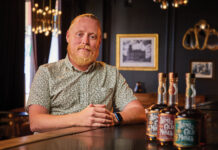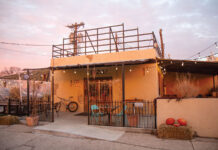Steve McCarthy is the owner of Clear Creek Distillery in Portland, OR, which has been producing artisanal spirits since 1984. Starting with an eau-de-vie made from Bartlett pears grown on this family’s orchards in Hood River, McCarthy now produces pear, plum, raspberry, cherry, marionberry, and apple brandies, as well as grape brandy, grappa, and single-malt whiskey. I sat down with Steve at his distillery to talk about the small-scale distilling business in November 2001.
AM: I’d like to start off our small talk by asking a “big” question: what is the most important thing you’ve learned in your experience in running a small distillery?
SM: Well, that’s the right question. Distilling itself is lots of fun. If you’ve been a winemaker or a brewer, there are obviously things to learn , but it’s not extra ordinarily d fficult. And if you plunk down the money and buy a good still, and you spend a little bit of time learning the rudimentary aspects of running it, then dis- tilling is really quite straightforward .
Good winemakers and good brewers should give it a try. If they keep their wits about them, they will make decent distilled spirits fairly early on. Most people that try it discover that it’s great. The legislation — existing federal legislation isn’t unduly burdensome . It’s possible to get what’s called an experimental license, a kind of quickie, and you can start distilling legally. And if you can buy car insurance, you can get a federal distilling license. It’s not difficult — you need a bond, the forms are maddening, but once you get through them, then you never have to do it again. The licensing decision by the Feds is not a discretionary decision. They have to give you the license . It’s not that big a deal . It’ s not more difficult than starting a restaurant — probably less difficult. Then of course you have the state authorities, state department of agriculture, city land use people. So there’s lots of hoops to jump through, but it’s kind of like everything else in modern life.
So distilling is fun, but making a real business out of it is different. As my good friend Matt Kramer, the wine writer, used to say, “Are you in business, or are you in love?” You want to know which one you are, because it will determine how you operate. If you’re in love, then you should for God’s sake stay small and have a great time. If you’re in business, you should start small and then try to grow. My advice to peo- ple — and I get about one phone call about this every two weeks — is start small. Then as you work through the produc- tion issues, and the packaging issues, and the regulatory issues and you begin to sell your product, you’ll know when it’s time to grow. I think that the biggest mistake I made was that early on, I tried to grow too fast. There is a limit to how far the market will respond to little distillers.
AM: But didn’t you also have the disadvantage when you started off a lot of people not even knowing the existence of some of the products you were trying to make? That’s not the case any more.
SM: I think that’s right. We’ve made enormous progress in 17 years. But every day I encounter people who have never heard of eau-de-vie, andmay or may not like it. So we’re not done. The issues of making a business out of it are much more difficult than I imagined. In the first place, good eau-de-vie is very expensive. The materials are expensive: there’s 30 pounds of pears in a bottle of my pear brandy. If you buy good fruit — and we grow our own fruit — it’s going to cost some money. One of the mistakes people make is to try to use cheap fruit. If you use cheap fruit, you will produce brandy that tastes cheap. It’s like good winemaking or good brewing in that respect.
This is a production process where “less is more.” You really want to fool with the fermentations and the fruit as little as possible. You want to baby that pear along, and gently extract that eau-de-vie from it. The mistake that many of my friends who have started distilleries made was that they bought all the equipment, and at that point thought it was going to be easy. But that’s when it really gets hard.
What happens, and I’ve seen this in several small scale— what I call artisan — distilleries, is that a guy comes along — and it’s always guys (I think they’re just too damn pig- headed) — they sink all the money in and they get the plant running and at that point the money’s gone. Then they rap- idly lose the joie de vivre and the sense of humor that they need to sell it. They start cutting corners, maybe in quality, maybe in people, and they make mistakes. It’s painful to watch. You get this guy who spends half a million bucks and the money’s basically wasted, because he doesn’t have the other half million or whatever it’s going to take to hang on, to keep the quality where should be, to remain cheerful, and to put up with the abuse that you’ll take in the marketplace.
So the best advice I have for people who want to start this as a business and not as a romance is start small, stay small, and be prepared for a long, long period before you’ll break into the market.
▼ ▼ ▼
Alan Moen of Entiat, WA is editor of American Distiller. He has been writing about beer, wine, and spirits for the past 10 years. Moen can be reached at alanmoen@televar.com.








